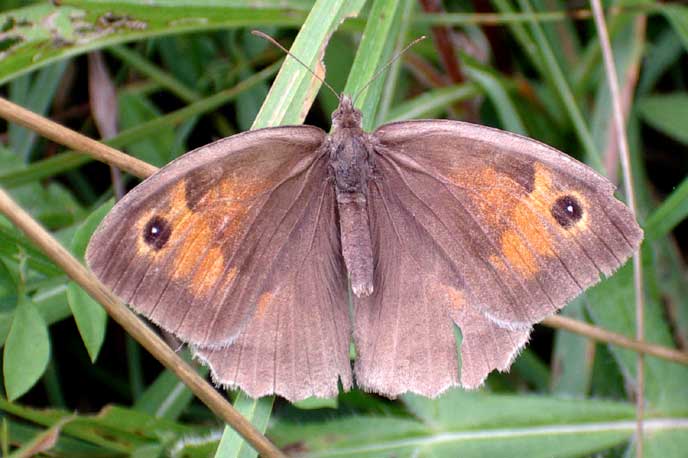

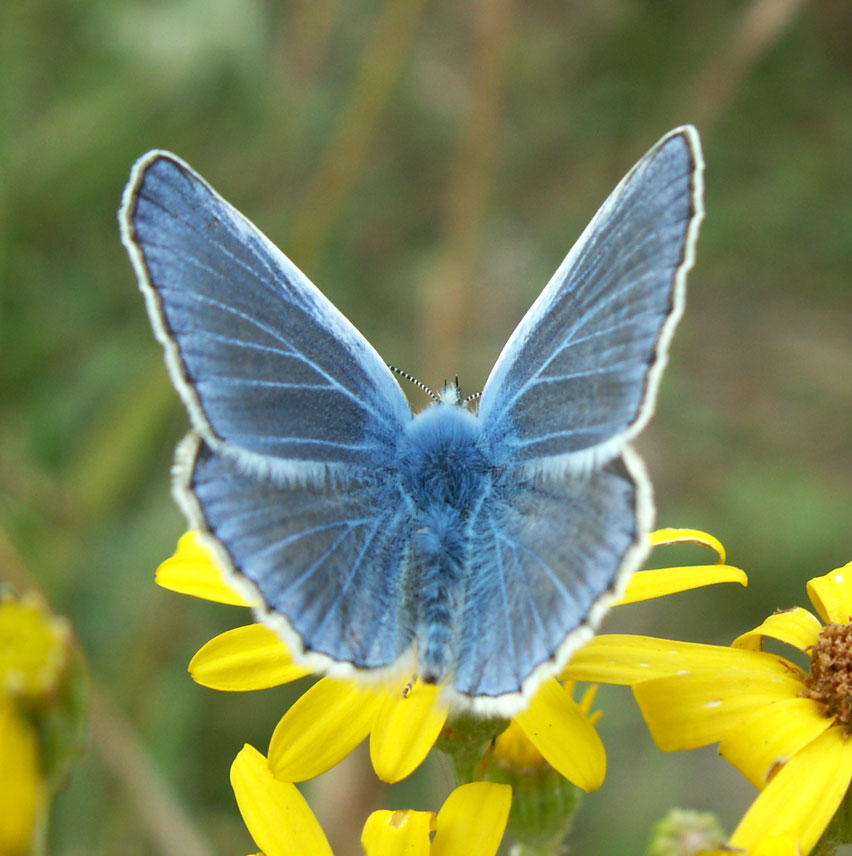

 |
 |
 |
 |
|
|
|
|
|
Noticeable
plants of the upper meadows include Greater
Knapweed, Hardheads (=Lesser Knapweed),
Field
Scabious, Meadow Cranesbill, Alexanders,
Pyramidal
Orchids,
Yarrow, Eyebrights,
Musk
Thistles,
Perforate
St. John's Wort, Sweet
Violets, Horseshoe
Vetch (in May)
and many others.
Some
Indicator Plants of Ancient Downland (Link)
Spring
Butterflies (Mill Hill)
| OVERVIEW:
A large part (724 acres) of the downs including Mill Hill were presented to the people of Shoreham in 1937. Just over 30 acres still remain as public open land. This is divided into about 11 acres of grassland and meadows above the ridge, about 9 acres of scrub, the copse and glades at the northern end, and about half of the prime Chalkhill Blue area of 6.4 acres of herbland remaining. The casual visitor will usually miss the best area. Six acres of butterfly land was lost to a Sycamore woodland on the southern slopes. This is low fertility chalkland not suitable for grazing. The top area is effectively a wild meadow and the lower slopes a rabbit warren dominated by prostrate (not the upright form) Horseshoe Vetch. |
|
||||
| Chalkhill Blues:
Mill Hill
is nationally important because of its population of Chalkhill
Blue Butterflies. Estimates of the numbers
are notoriously inaccurate. In the 1950s the population was estimated by
R. M. Craske to be 50,000. This may be an
exceptionally good year. I would estimate the numbers at that time to be
nearer 25,000 for Mill Hill only. After the cattle grazing and thorn incursions
the numbers plummeted to the most reliable estimate in 1960 of 6,000. The
new road and Sycamore woodland further denuded the Horseshoe
Vetch and bare chalk downland to a figure
I have estimated at a top figure of 3,000 Chalkhill Blue Butterflies at
the turn of the millennium (counted in 2003). Almost all these butterflies
are now to be found on the six acres of the lower slopes.
Text
by Andy Horton
|

 |
||||
| "Our family
lived at The Mill House, Mill Hill, from around 1933 until about 1967,
and every July we saw the "Butterfly Men" walking past onto the
Downs. My father used to tell us that they were interested in the blue
butterflies."
Heather
Clark (née Eager), Ryde, Isle of Wight
|
Mill Hill Wildlife Reports 2007 (Link)
17
December 2006
 A
brief visit located at least three flowers of Sweet
Violet in a patch on the steep slopes
of the southern Mill Hill, just the one
Hawkweed? seen on the lower
slopes of Mill Hill, a diminutive 12 cm Ragwort*
on the Old Erringham pasture, followed by a Small
Scabious on the ridge of Mill Hill. The
count was ten species in about an hour. The frequent flowers of Carline
Thistle on Mill Hill were assumed to be
dead and their leaves were silvery. (*
Species not defined and could be Oxford Ragwort?)
A
brief visit located at least three flowers of Sweet
Violet in a patch on the steep slopes
of the southern Mill Hill, just the one
Hawkweed? seen on the lower
slopes of Mill Hill, a diminutive 12 cm Ragwort*
on the Old Erringham pasture, followed by a Small
Scabious on the ridge of Mill Hill. The
count was ten species in about an hour. The frequent flowers of Carline
Thistle on Mill Hill were assumed to be
dead and their leaves were silvery. (*
Species not defined and could be Oxford Ragwort?)
(?
Not
absolutely sure of the the ID: Image.
The
leaves were not be seen.)
21
November 2006
The
South
Downs Conservation Board were constructing
their unpopular water troughs for cattle. There is local opposition (almost
unanimous) to putting cattle
on Mill Hill. The land is not suitable for grazing and the cattle will
quickly and permanently destroy the butterfly food plants.
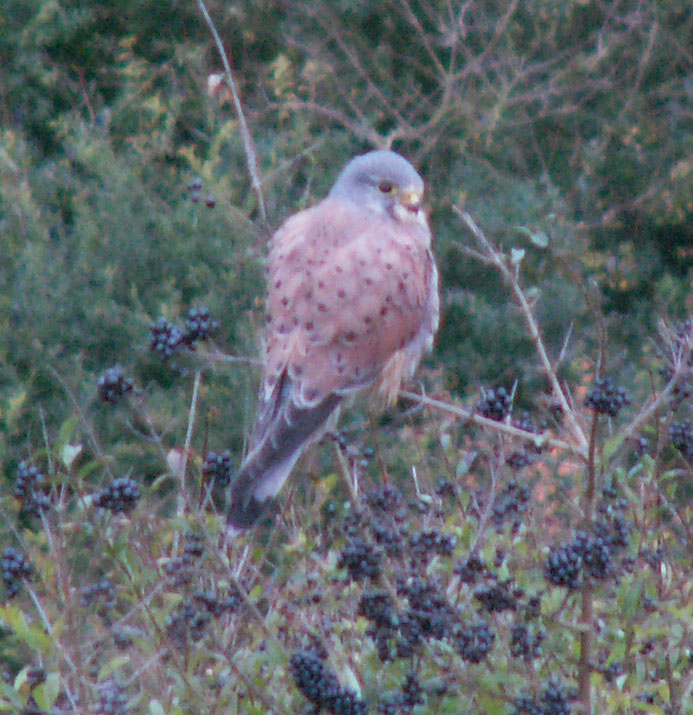 16
November 2006
16
November 2006
There
were no signs of any butterflies or flying
insects on the overcast afternoon, after the showers (3.81
mm) in the morning. I spotted a male Kestrel
resting on a Privet
bush with his back to me, and below me as I walked along the ridge, and
it was there for 30 seconds before he spotted me and flew off. Later a
Wren
(probably numerous on the scrubby downs) flitted
in front of me and a Robin
called territorially from the top of a Hawthorn.
The remains of a Field Mushroom
were seen on the ridge north of the Reservoir.
13
November 2006
Four
Clouded
Yellow Butterflies and one Red
Admiral were seen on Mill Hill. One of
the Clouded Yellows
rested on my finger. It was rather bedraggled.
9
November 2006
Eleven
Clouded
Yellows, including one form helice
were seen at Mill Hill in the afternoon about 3:00
pm. Despite the fair (11.8
ºC) weather they were rather sluggish,
spending most of the time on either warm scree or the wooden boards of
the steps and tilting themselves perpendicular to the sun's rays.
6
November 2006
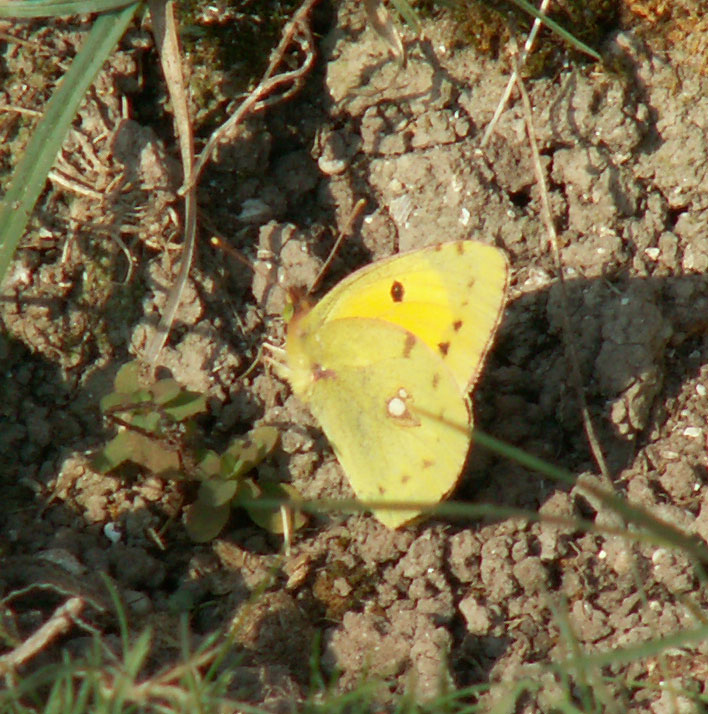 On
a clear day, 11 (to 13*) Clouded Yellow
Butterflies were seen on Mill Hill (6
-8* on the lower slopes and one on the
ridge by the Reservoir) and on Old Erringham pasture (4). One of the Clouded
Yellows had white upper wings but conventional
(if slightly paler) underside, and one was a faded yellow and very tatty.
They were very flighty, rarely stopping for more than a few seconds at
each flower, and on the lower slopes of Mill Hill they visited Devil's
Bit Scabious (in hidden places I had not noticed
it before) and Autumnal Hawkbit
and Wild Basil.
On the Old Erringham pasture near the stile adjoining Mill
Hill Nature Reserve, two of them were courting rising together vertically,
and their preferred nectar plant was Dandelion.
On
a clear day, 11 (to 13*) Clouded Yellow
Butterflies were seen on Mill Hill (6
-8* on the lower slopes and one on the
ridge by the Reservoir) and on Old Erringham pasture (4). One of the Clouded
Yellows had white upper wings but conventional
(if slightly paler) underside, and one was a faded yellow and very tatty.
They were very flighty, rarely stopping for more than a few seconds at
each flower, and on the lower slopes of Mill Hill they visited Devil's
Bit Scabious (in hidden places I had not noticed
it before) and Autumnal Hawkbit
and Wild Basil.
On the Old Erringham pasture near the stile adjoining Mill
Hill Nature Reserve, two of them were courting rising together vertically,
and their preferred nectar plant was Dandelion.
(*
The Clouded Yellow Butterflies
were flighty, chasing each other at speeds of an estimated 10 mph and the
lower figure of 11 seen means that no butterflies were counted twice. They
appeared to be resident in the area, rather than just passing through.
One of their caterpillar food plants, Bird's
Foot Trefoil, is abundant on Mill Hill.
)
Butterfly
List 2006
 |
27
October 2006
I spotted what were half a dozen probable Lactarius pubescens (a type of Milk-Cap)* on the verges of Mill Hill Road where the Bee Orchids were discovered earlier this year. They were on grass and herbland about one metre from two Silver Birch trees. *
Probable
Identification by Mark
Pike on the Fungi
of the British Isles (Yahoo Group)
|
 23
October 2006
23
October 2006
Amongst
a patch of long grass near (west of) the Reservoir and surrounded by Hawthorn
bushes, the tall mushroom Volvariella
gloiocephala was spotted to the side
of me as I walked along the path.
Adur
Fungi 2006
20
October 2006
Butterflies
at Mill Hill, Shoreham in the sunshine out of the breeze after a very wet
morning: 1 Red Admiral;
1 Meadow Brown
(very tattered) and an amazing 10 Clouded
Yellows.
12
October 2006
Under
the midday sun a remarkable air temperature of 16.6
°C was attained
which brought seven species
of butterfly out: Red
Admirals (26),
Comma
(2),
Large
White (1),
Clouded
Yellow (3), Meadow
Brown
(9+),
Common
Blue
(3)
and a Peacock Butterfly
(1). This was the first ever
record of
a Peacock Butterfly
during the month of October
recorded on these Nature Notes. It is seen
very clearly before it flew upwards and away. All the butterflies were
seen in just over an hour on Mill Hill and the approaches to this small
public open space nature reserve north of
Shoreham-by-Sea.
Full
Butterfly Report
Adur
Butterfly Flight Times
Shoreham
Weather Reports 2006
7 October
2006
Two
Comma
Butterflies, one Red
Admiral, one Meadow
Brown and one Clouded
Yellow were seen on Mill Hill.
3
October 2006
There
were at least seven Common Blue Butterflies
and 18 Meadow
Brown
Butterflies all on the lower
slopes of Mill Hill, and one Small
Copper on the Devil's
Bit Scabious.
Adur
Butterfly List 2006
11
September 2006
A
Small
Copper Butterfly that landed on a path
in front of me through the long grass on the Mill Hill gentle slope west
of the upper car park came as a surprise with the ordinary fare of butterflies
on a sunny early afternoon. The butterflies are fading earlier this year
and the upper meadows on Mill Hill had only a small population of the frequent
Common
Blues.
The
lower slopes were much reduced as
well. The overall numbers of the others were Speckled
Woods 10+, Large Whites 15+, a
few Green-veined Whites, Clouded
Yellows 8, Small
Heaths 13,
Adonis
Blues
22,
Chalkhill
Blues 2, a few Red
Admirals, a possible Brown
Argus or a few (to be confirmed), one
bright Comma
in the Hawthorn wood of the north-west, and with the most numerous Meadow
Browns
40+
that was it. Treble-bar
Moths (25+) were frequently seen on the
lower slopes of Mill Hill.
The
dragonflies
known as Common
Darters
and
Southern Hawkers
(including mating pairs) were seen occasionally.
A
handful of Swallows
and/or House Martins
swooped low over Mill Hill.
6 September
2006
With
the sun out and the air temperature rose to
24.2 ºC at 1:15
pm, humidity
74%, I just could not stay in so I went for
a small cycle ride after the gales of two days ago.
On
a humid day the first Autumn Gentian
and Autumn Lady's Tresses
(an orchid) were spotted in flower on the upper
part of Mill Hill (just north of the Reservoir).
These are both small plants that can
only be seen in the short sward.
 |
 |
Mill
Hill blown about by a negligible Moderate
Breeze added a further selection of butterflies
including 49 Adonis Blues,
very frequent Meadow Browns
on
the lower slopes with, occasional white
butterflies,
occasional confirmed Brown
Argus
Butterflies, but
just the two mating Chalkhill
Blues. The scrub in the north-west
added a Comma
that
flew over the lower slopes, and at least five Speckled
Woods. Just a small part of the top area
visited was attractive to three Small Heath
Butterflies, a Brimstone
Butterfly with a few mostly female Common
Blues
and occasional Meadow
Browns.
|
|
|
|
|
| Mill Hill lower |
26
|
10
|
|
| Old Erringham pasture |
1
|
0
|
|
| Mill Hill, middle & upper |
9
|
3
|
27
August 2006
 Adonis
Blues
(128+)
were
mating on Mill Hill on a breezy midday.
The count was 110
(about
13 females seen) on the lower
slopes and 18 males
above the ridge. This was the most I have ever counted on Mill Hill. There
were occasional Common Blues
on the lower slopes and they were still frequent on the upper meadows so
distinguishing the species was not always automatic. The Adonis
Blues were evenly spread over the lower slopes
and I would estimate their numbers on Mill Hill at 350+.
All the females
were mating or heavily courting (about to mate).
Adonis
Blues
(128+)
were
mating on Mill Hill on a breezy midday.
The count was 110
(about
13 females seen) on the lower
slopes and 18 males
above the ridge. This was the most I have ever counted on Mill Hill. There
were occasional Common Blues
on the lower slopes and they were still frequent on the upper meadows so
distinguishing the species was not always automatic. The Adonis
Blues were evenly spread over the lower slopes
and I would estimate their numbers on Mill Hill at 350+.
All the females
were mating or heavily courting (about to mate).
Chalkhill
Blues were still frequently seen and the
figure of 25+
(20 lower, 5
middle and upper Mill Hill) may be under their numbers as I lost count
of them. Meadow Browns (70+)
were still very frequent, but Small Heath
Butterflies (6) were only occasionally
seen, with one Wall Brown that
did not settle for confirmation over the lower slopes. Large
Whites were frequent over the downs,
and at least one Small White
was seen in town. Almost all the whites, even the smaller ones were Large
Whites (although it was not easy to be sure).
About a dozen Speckled Woods
were seen in the scrub in the north-west of Mill Hill. Faded Brown
Argus Butterflies were confirmed occasionally
flitting with the Common Blues
on the top meadow.
Butterfly
Report
A flock of seven Rooks flew over, but headed towards Old Erringham.
20
August 2006
With
the weather forecast predicting rain for the next week, I
ventured up the downs even though the conditions
(20.2 ºC at 11:00
am, 83% humidity,
Wind Force 4 falling to Force 3, direction southerly at Azimuth 158º)
were
far from ideal for butterflies.
 |
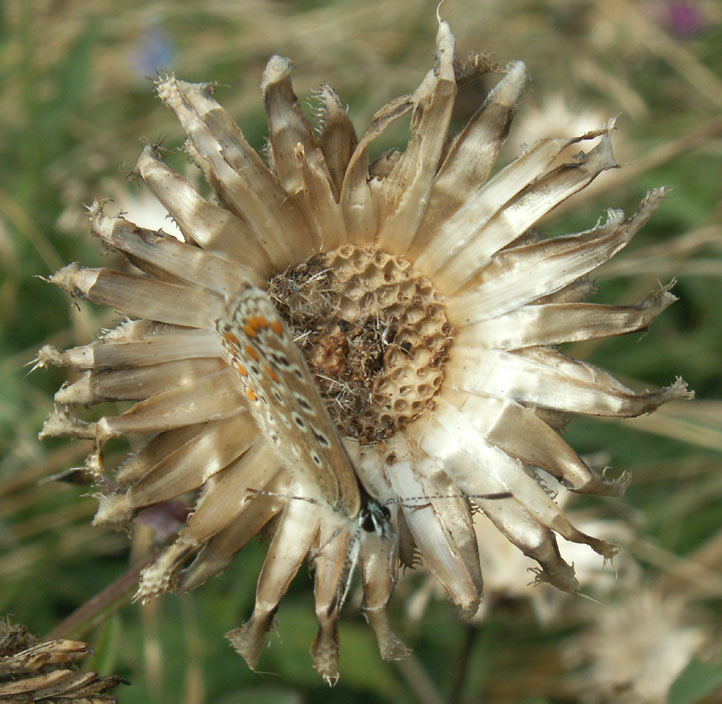 |
The dead heads of Greater Knapweed could be seen all over the meadows of the upper part of Mill Hill |
Predictably
most of the butterflies were hiding and the numbers on Mill Hill actually
seen were down from the last visit. The walk did not involve stopping and
the count was Chalkhill Blues (50)
and Adonis Blues (49). The
Chalkhill
Blues were thought to be undercounted as just
north of the Reservoir on the upper part of Mill Hill, I instantly saw
one Chalkhill Blue Butterfly,
but I dawdled for a couple of minutes and a further seven appeared out
of nowhere. Only about five
female Chalkhill
Blues were included and no female Adonis.
Most of these were seen on the lower slopes.
Common
Blues
(90+)
were the most numerous butterfly, but these were in far greater numbers
on the meadow north of the upper car park where an estimated 60 were seen
compared to about 30 on the rest of Mill Hill. These were only a fraction
of the total as they were the ones disturbed from the tall herbs (with
a large amount of Greater Knapweed) in the meadow. Some of the females
were a very dark chocolate brown and much smaller, and there were a confirmed
handful (probably many more) of Brown Argus
Butterflies.
| Counts | Chalkhill Blues | Adonis Blues | Common Blues * |
| Lower Slopes of Mill Hill | 29 | 43+ | 15 |
| Pasture (near the stile) at Old Erringham | 0 | 3 | 3 |
| Triangle middle are of Mill Hill | 3 | 3 | 10+ |
| Meadows north of the car park | 0 | 0 | 60+ |
| Passage over the upper part of Mill Hill | 8 | 0 | 2+ |
| Mill Hill Cutting (SW) | 0 | 0 | 2 |
| Mill Hill Cutting (SE) |
0
|
0
|
8
|
(*estimated actually seen)
Meadow
Browns
(75) were widespread with an estimated
50 on the lower slopes where a single pristine Wall
Brown and a single Small
Heath were noted. Red
Admirals were occasional, one Painted
Lady was seen in the central
area, and four Small Whites
in the meadow north of the upper car park, all on Mill Hill. About ten
Speckled
Wood Butterflies were a familiar sight
as I walked through the scrub on the north-west
of Mill Hill.
Adur
Butterfly List 2006
 17
August 2006
17
August 2006
Common
Blue
Butterflies (100+) were still common on
Mill
Hill, and both the second brood male
Adonis Blue Butterflies (66+) and the
worn Chalkhill
Blues
(72+)
were very frequently seen on the downs and
surrounding areas. The Adonis
and Chalkhill Blues
were counted, but the plus signs are included because if there as any doubt
if it was an Adonis
or a Common Blue
it was put down as a Common Blue,
and with Chalkhill Blues,
possible duplicates were excluded and females
are likely to have been overlooked. The Adonis
Blues were in a bright pristine condition
but many of them already showed nicks out of their hind wings. This is
the largest count for the second brood Adonis
and nearly the largest seen on Mill Hill in one day. The list included
very frequent Meadow Browns (75+)
on
grass and meadows, frequent Speckled Woods
(25+) in scrub and shady bits on Mill
Hill.
| Counts | Chalkhill Blues | Adonis Blues | Common Blues * |
| Mill Hill Cutting (SW) | 8 | 0 | 0 |
| Lower Slopes of Mill Hill | 57+ | 57+ | 20 |
| Pasture (near the stile) at Old Erringham | 1 | 3 | 4 |
| Triangle middle are of Mill Hill | 5 | 3 | 12 |
| Meadows north of the car park | 0 | 0 | 50+ |
| Passage over the upper part of Mill Hill | 1 | 3 | 2 |
| Slonk Hill Cutting south | 0 | 0 | 20 |
(*estimated actually seen)
The correlation between the distribution of the butterflies is both the Adonis Blues and Chalkhill Blues are centred around the presence of the correct prostrate type of Horseshoe Vetch on the short sward. The Common Blues larvae feed on Bird's Foot Trefoil and roost in the tall grass meadows. The pasture and agricultural meadows do not support any larval butterflies, but contain vagrant butterflies. The Holly Blue larvae feed on Holly and Ivy and the adults (imago) of this butterfly is to be found near hedge containing both of these larval food plants. Brown Argus are found in the tall meadows. Their larval plant on Mill Hill is still undecided but it could be Meadow Cranesbill.
6 August
2006
It
is strange how the Common Blue
Butterflies of two days ago quickly diminished
or dispersed and the estimate was now less than half at only 100
on
Mill Hill. Chalkhill Blues
were counted at 176
(lower slopes 108
middle and upper 39
Mill Hill Cutting 29)
and the first second brood male Adonis
Blue was seen on Mill
Hill. Brown Argus (40+) flitted
with the silver underwings, and there were sufficient numbers of them in
the meadows north of the upper car park on Mill Hill, to be sure of them,
if not their numbers which could have been much more than forty, possibly
a 100+.
Butterfly
Report
4
August 2006
There
were so many Common Blue Butterflies
in the meadows north of the upper car park, it defied counting them. I
must have disturbed at least 200
in 15 minutes or so as I ploughed through the dense meadow. My
estimate (conservative guess) of their numbers on Mill Hill was 4500.
Brown
Argus
Butterflies (20+) were seen frequently
on Mill Hill and now confirmed by a photograph which was not successful
on the previous visit five days earlier. The figure of 20 is no more than
a guess as it was difficult to separate them from the older female Common
Blues as the blue butterflies fluttered all
over the place at a density of about five a square metre at times in the
meadow north of the upper car park, but not everywhere like this on the
hill.
 |
 |
 |
| Confirmed Brown Argus Butterfly from the tall meadows north of the upper car park |
(photographed on the nearby Slonk Hill Cutting) |
This dense meadow was typical of south of the Reservoir, near the road. Spot the female Chalkhill Blue on the Hardheads (=Lesser Knapweed) |
Chalkhill
Blues (122) were counted on Mill
Hill only (Mill Hill estimates at 450
on the hill). This
puts the Chalkhill Blues
past their peak early this year. Female Chalkhill
Blues were at 20% on the lower
slopes of Mill Hill. They were counted at 100
on the lower slopes, 12 in
the middle area and 10
at the top, but I hurried over the upper area and did not stop for any
of the visit.
Other
butterflies
included frequent Meadow
Browns
and
Gatekeepers, occasional
Small
Whites, Speckled Woods and
Red
Admirals, two Wall
Browns, two
Brimstones
and one Painted Lady.
The
yellow flowers of Great Mullein
were just beginning to show at the top of the steps down to the lower slopes.
Butterfly
Report
 30
July 2006
30
July 2006
Chalkhill
Blue Butterflies showed just an average
year on Mill Hill with just 151
recorded on the lower slopes in the sunshine,
and another 40+
on the upper area, which equates with an estimated day record on the wing
of about 650 on
Mill Hill. This was disappointing compared to 2003.
Stemless
Thistle was the most often used nectar plant,
although Round-headed Rampion
was also seen used on one occasion.
Females
were
at 5% only and probably under-recorded.
The other butterflies on Mill Hill included Common
Blues
(90+),
Meadow
Browns,
Gatekeepers,
Small
Whites, Red Admirals, Large
Whites, Speckled Wood,
Small/Essex
Skipper, Marbled White (10+), Wall
Brown (1), Small Heath (1) and
Painted Lady (2). Brown Argus Butterflies
were suspected, but all the photographs indicated female Common
Blues.
Butterfly
Report
On
the southern part of Mill Hill, A Hornet
Robber Fly settled on the path and another
one landed briefly on the Pixie Path.
Adur
Flies
23
July 2006
It
was cooler and just about tolerable to observe 11
species of butterfly
during one hour of the morning on Mill Hill. Chalkhill
Blue Butterflies led the way with over
163
seen and
136
of these seen within 20 minutes on the short herb sward of the lower slopes
of Mill Hill. Some Common Blue Butterflies
had emerged since my last visit, and these were seen in the long grass
upper meadows, but because of a rain squall, I have no idea of the numbers
involved. The other species of butterfly seen were Gatekeeper,
Meadow
Brown,
Small Skipper, Large Skipper (1),
Marbled
White,
Large
White,
Red Admiral,
Painted
Lady and Speckled
Wood.
Stemless
Thistle was noted as very frequent with
Round-headed
Rampion, Field Scabious, Greater
Knapweeds etc.
Butterfly
Report
Adur
Moths
 |
 |
 |
On
the upper meadows the grass had turned yellowish amongst a majority of
greenery as illustrated above with a Common
Blue Butterfly (there was a Chalkhill
Blue nearby as we
were swamped by a rain squall) and then a minute later a Large
Skipper and Red
Admiral. This the meadow area immediately
north of the car park where the Meadow
Cranesbill seems to be getting swamped
out by the long grass. This dried grass is in contrast to the parched green
herbland of the lower slopes.
The
photograph on the far right above shows the Round-headed
Rampion.
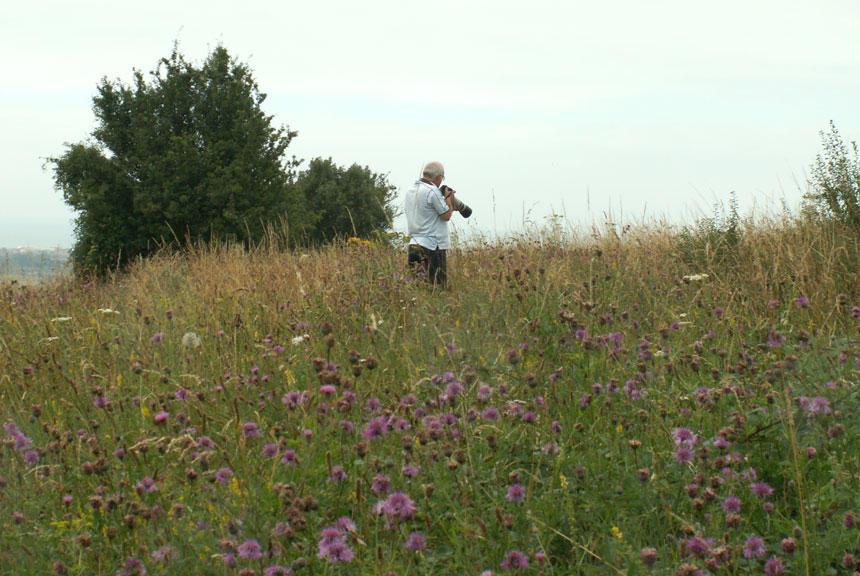 |
In
this photograph you can get some idea of the height of the vegetation in
the meadows to the north of the upper car park.
The lower slopes are completely different and the herbs are no more than ankle height. |
17
July 2006
There
was dead Grass Snake
on the Mill Hill side of the road bridge over the A27, already attacked
by flies in the baking sunshine and right at the edge of the bridge near
the footpath and the first house.
It was simply too warm and I gave up recording butterflies after about 12 minutes and returned by the ridge path, now overgrown. The frequencies are from the 12 minutes on the lower slopes only.
Large
White = occasional
Gatekeeper
= frequent
Meadow
Brown = occasional
Small
Skipper = occasional
Chalkhill
Blue 19
=
frequent
Marbled
White 16
=
frequent
15
July 2006
I
led a small party of children from my sons' school on a butterfly
hunt to Mill Hill, Shoreham. We saw 6
Large
White, 5 Small
White, 2 Large
Skipper, 4 Small
Skipper, 6 Red
Admiral, 5 Clouded
Yellow, 1 Speckled
Wood and 1 Brimstone.
We gave up counting large numbers (30+) of Painted
Lady, Marbled
White, Gatekeeper,
Meadow
Brown and Chalkhill
Blue.
 |
 |
 |
 |
On
a day of weak sunshine, the following plants were noted in flowers for
the first time on Mill Hill: Wild Basil,
Round-headed
Rampion and Stemless
Thistle. Especially on the upper slopes,
the large flower of the Greater Knapweed,
Field
Scabious and Lady's
Bedstraw* were prominent in the long grass
meadows. (* to be checked out for other plants.)
Marbled
White Butterflies appeared almost immediately
on the lower slopes, followed by four Chalkhill
Blues before their season had started.
They seem to be much paler than the later emergers and I have noticed this
before. Gatekeepers
were frequent, the most prevalent butterfly a shade ahead of the Small
Skippers with the occasional Meadow
Brown
and Red
Admiral.
Butterfly
Report
Adur
Wild Flowers
Adur
Moths
 3
July 2006
3
July 2006
A
surprise very early couple of Chalkhill
Blue Butterflies were seen on the
lower
slopes of Mill Hill. In the sunshine I was unable to chase the skippers
around to discover what they were. There could have been my first Small
Skipper of the year.
Marbled
Whites led the way with 49 counted, with
at least 36 recorded on the lower slopes. Meadow
Browns
were
frequently seen. A handful
of Cinnabar Moths
and Silver Y Moths
were recorded on the upper meadows of Mill Hill.
Butterfly
Report
Adur
Butterfly First Flight Times
Meadow's Cranesbill was in flower but it looked like it was being overgrown by grasses and other vegetation.
29
July 2006
A
female Stag Beetle
was flying around in our lounge in Mill Hill Close (south of Mill Hill)
after darkness. This is number five we have seen. They were surprisingly
nimble in flight but very noisy.
24
June 2006
A
Stag
Beetle was spotted slowly running around
my garden in Mill Hill Close (south of Mill Hill) in the early evening.
20
June 2006
The
first Marbled White Butterfly
of the year fluttered strongly over the
lower
slopes of Mill Hill where the Horseshoe
Vetch flowers had almost disappeared and the
corkscrew-like seed pods could be discovered if searched amongst the emerging
herbs and new flowers. The largest yellow
patches on Mill Hill were now Bird's Foot
Trefoil. Meadow
Vetchling was recorded. Butterflies
were frequent (about 50), but not common. The most prevalent on Mill Hill
were now Common Blues
and Small Heath Butterflies
with about 15 each.
The
hoverfly
Rhingia campestris
fed on Greater
Knapweed on the middle Triangle
area of Mill Hill. It was breezy at the top of the hill. Smooth
Sow-thistle, Sonchus oleraceus, was
recorded in the copse at the top of Mill
Hill.
Butterfly
Report & List
Adur
Butterfly First Flight Times
 15
June 2006
15
June 2006
With
wild
flowers bursting into flower everywhere, the highlight was about a
hundred Bee Orchids
in Mill Hill Drive. There was one Kidney
Vetch flower seen on the Triangle
section of Mill Hill. The first Greater
Knapweed was seen in flower and Field
Scabious.
About
half of the 25 Adonis Blue Butterflies
on Mill Hill showed signs of raggedness
and age, whereas the Common Blues
appeared fresher. I spotted my first
Meadow
Brown
Butterfly of the year on the lower
slopes, where I was surprised at a settled late Grizzled
Skipper and I had a better look at a Large
Skipper.
There
were eleven different species in an hour.
Full
Butterfly Report
A
Silver
Y Moth, a Burnet
Companion, a Treble-Bar
and two pretty Mother Shiptons, Callistege
mi, were all seen on Mill Hill.
A
Skylark
rose into the air.
12
June 2006
The
first Meadow Brown
Butterfly of the year was seen on Mill
Hill. Other butterflies seen were Dingy
Skipper (1), Small
Heath (10), Adonis
Blue (many,
including several egg laying females), Common
Blue (20), Brimstone
(2), Small
White (4), Painted
Lady (1).
11
June 2006
Amongst
the long grass meadow north of the top car park on Mill Hill, I had a brief
sight of my first Large Skipper
of the year (the only skipper of the day).
I did not get a good a look as I would have liked to identify it, but Large
Skippers precede the Small
Skippers, so that is what it was. Adonis
Blues (45
to 53 +) were
most numerous on the lower slopes and the other species recorded were Common
Blue, Large White,
Speckled
Wood (6), Holly Blue, Red
Admiral
and
Small
Heath (8).
Eight
species.
Adur
Butterfly First Flight Times
Butterfly
Report (all sites)
Near the reservoir a group of five Magpies followed by a sixth were making a tremendous chattering racket.
On
the lower slopes the Horseshoe Vetch
had diminished considerably (it could not be seen from a distance), but
the later growths on the middle and upper slopes showed patches even amongst
the long grass with a handful of Adonis Blue
Butterflies.
| 29
May 2006
The Old Erringham pastures were examined for their flora. It was quite different from Mill Hill with a higher proportion of grasses, but with a selection of herbs (excluding grasses), especially noting that the dramatic explosion of Bulbous Buttercups, with the blue Milkwort doing very well, and both Horseshoe Vetch and Bird's Foot Trefoil noted in small amounts. Images 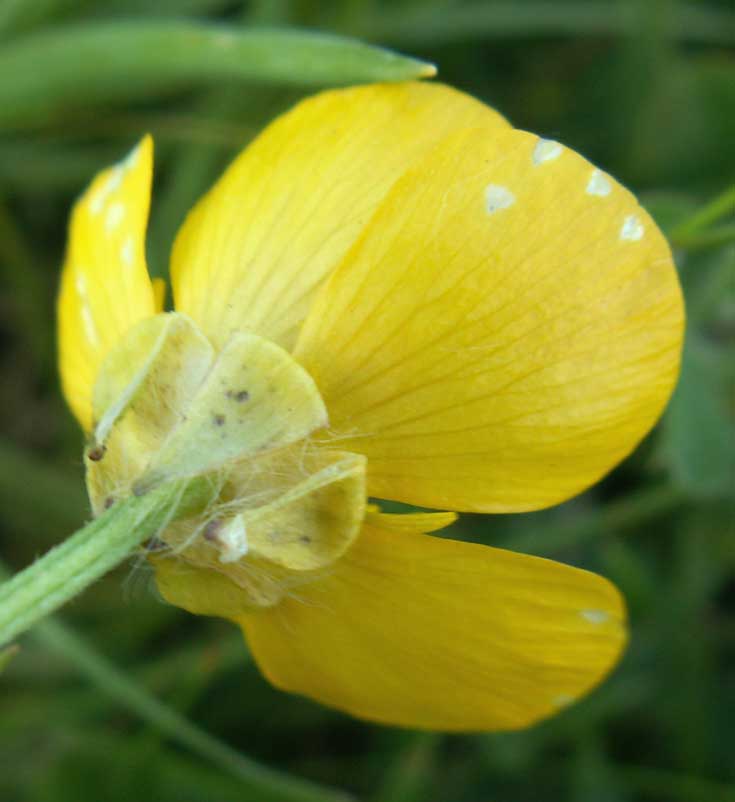 Adur
Buttercups Adur
Buttercups |
 |
 |
 |
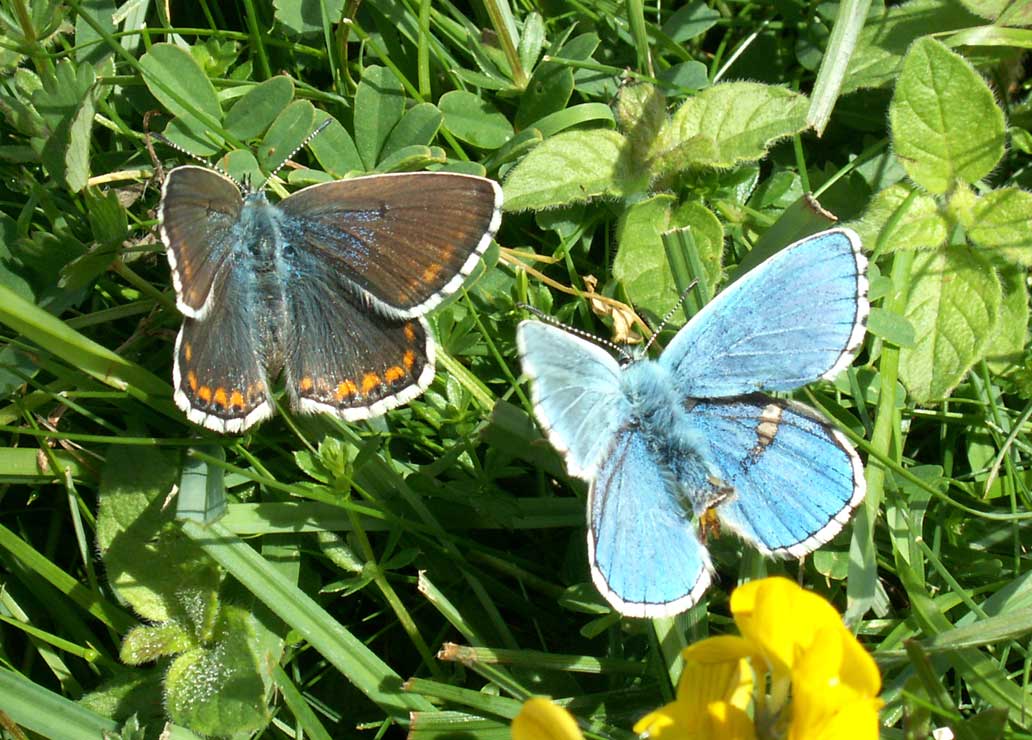 |
 |
The
prostrate
Horseshoe Vetch was prevalent
on the lower slopes, at about 70% of its luxuriance. Some flowers have
not yet opened and it has appeared at the northern end which it usually
does first, and has not yet appeared very much on the steeper banks, which
are always a week later. In the Triangle area
the Horseshoe Vetch was sparser than normal and on the upper plateau it
was not prominent and was not instantly visible. Surprisingly there were
some small patches of Horseshoe Vetch lost amongst the superabundant
Bulbous
Buttercups and a handful of patches of
Milkworts
in the Old Erringham pasture
to the north-west of Mill Hill Nature Reserve.
Also, in the meadow north of the upper car
park, an erect variety of Horseshoe Vetch
was spotted amongst the long grasses with a longer stalk (over 30 cm high,
but still lower than the sward) and less leaves than the plant on the lower
slopes. Summary: the Horseshoe Vetch is flowering
over a week later than the last two years.
 |
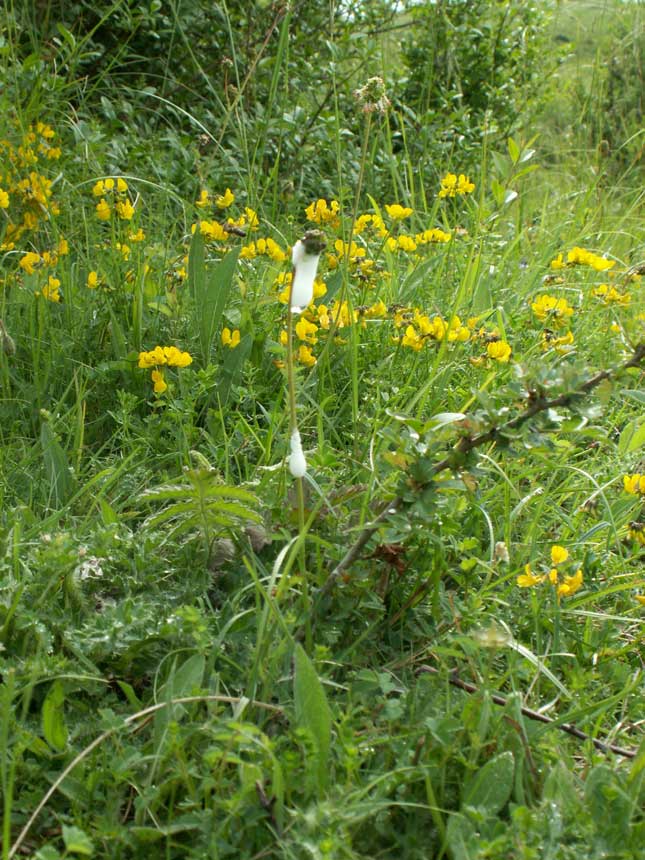 |
 |
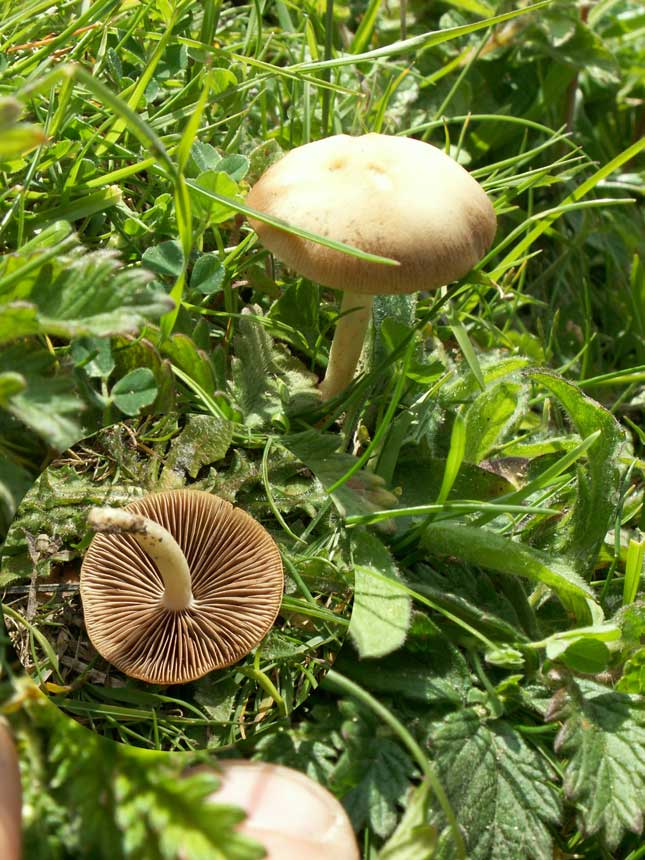 |
I traversed
the meadows around the upper car park and I did not note any butterflies
although a Small Heath Butterfly
was seen in the short sward near the reservoir. There were a few flying
insects illustrated above in the dense meadows and at least one mushroom
was noted in the short turf. The wasp mimic
is
a hoverfly, a species of Chrysotoxum.
| 21
May 2006
Three Swifts were seen (from southern car park of Mill Hill) flying over Frampton's Field before the cloud descended and obscured visibility and turned into steady rain that continued for the rest of the daylight. Image: Alexanders and Cow Parsley on the southern part of Mill Hill Nature Reserve |
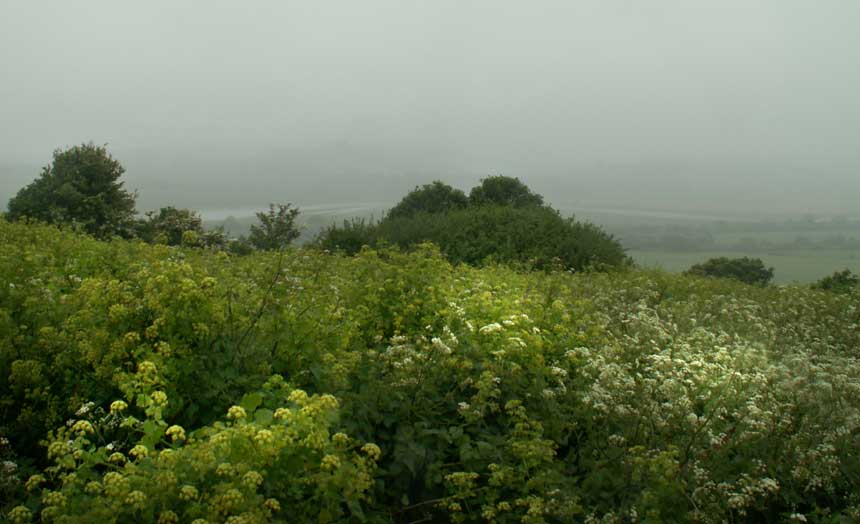 |
15
May 2006
My
first two Silver Y Moths
of the year flew from Frampton's Field,
Old Shoreham. My first two Wall Brown Butterflies
and my first Brimstone Moth
were seen on a brief visit to Mill Hill. Two female
Pheasants took flight from the Old
Erringham buttercup-strewn pastures immediately to the north-west of Mill
Hill. Silverweed
was flowering on Mill Hill. The leaves
of the Greater Knapweed were everywhere.
Full
Butterfly Report
 14
May 2006
14
May 2006
An
attractive Eyed Hawk-moth, Smerinthus
ocellata, was discovered on a Daffodil
in
my garden in Mill Hill Gardens, which was at one time part of Mill Hill.
At
10:00
am the resident Kestrel
hovered in the overcast sky before the start of the Butterfly
Walk on the lower
slopes of Mill Hill which produced just two Small
Heath Butterflies and a handful of small
Pyrausta
nigrata moths. The Horseshoe
Vetch was just beginning, only about 5%
of its full splendour. The sun struggled to come out in the afternoon and
I recorded my first male Adonis Blue Butterfly
of the year on the Shoreham Bank with
13
Dingy
Skippers, five Grizzled
Skippers and three Small
Heath Butterflies.
Full
Butterfly Report
Adur
Butterfly First Flight Times
| 10
May 2006
The small black flies Empis tessellata were common on the downs. ID
by Laurence Clemons
Adur
Flies |
 |
|
A note was made of the Brown-tailed Moth caterpillars in their silk cocoons. The caterpillars seem to strip the upper leaves completely (in the one example noted) but most of the Hawthorn is still in leaf and not stripped bare. In the nearby Hawthorn without caterpillars, no damage can be seen. On the lower slopes the number of small moths were notable with both Pyrausta nigrata and Pancalia being common (over 100 each). Five each of Dingy Skippers and Grizzled Skippers were recorded with a Peacock Butterfly and a Large White Butterfly. |
 |
1 May
2006
May
came in with a shower. On the lower
slopes of Mill Hill, the first Milkwort
was seen in flower and the exiguous beginnings of the Horseshoe
Vetch, Hippocrepis comosa.
A single first Grizzled Skipper
was recorded, the first of the year, with frequent (10+) small moths
Pyrausta nigrata, seen for the first
time this year,
26
April 2006
A
female
Pheasant whirred into flight on Erringham
Hill as a Kestrel
cruised overhead. South of the upper car park, a Rook
probed the ground as a Skylark
rose vertically and started singing until it was just a speck in the blue
and white cirrus sky.
At
the northern end of the lower slopes I
spotted my first Dingy Skipper
of the year that briefly sparred with a Peacock
and the size difference was most noticeable. The Dingy
Skipper is the first of I have heard of anywhere
this year. A few Sweet Violets
still flowered under the shade of the Hawthorn, but it was mostly Dog
Violets in
the open.
Adur
Violets
24
April 2006
Half
a dozen silken nests of the Brown-tailed
Moths were noticed on Hawthorn trees on
the southern part of Mill Hill.
19
April 2006
 |
This
attractive bee seen on the lower
slopes of Mill Hill was the first time the Tawny
Mining Bee, Andrena
fulva, has been recorded on these
Nature
Notes pages. It is a female. The species
is common and widespread.
Report
and Photograph
by
Ray Hamblett
(Lancing Nature)
ID by
Nicolas
J. Vereecken on the Bees, Wasps and Ants Recording Society (Yahoo Group)
on the Bees, Wasps and Ants Recording Society (Yahoo Group) |
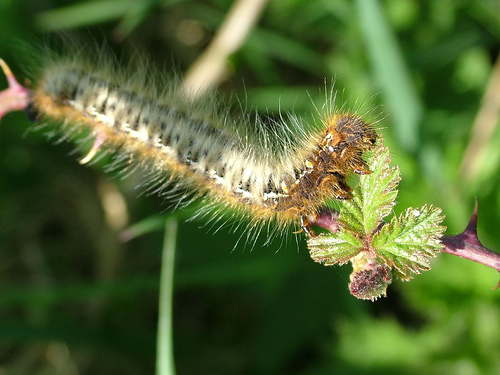 |
There
were many silk Brown-tailed Moth nests
on Brambles at
Mill
Hill, Shoreham and a caterpillar noted and shown the photograph. The
caterpillar was not connected to the silk nests and has been identified
as an Oak Eggar Moth, Lasiocampa
quercus, caterpillar (which
does not associate with Oak).
|
18
April 2006
Amongst
the plants noted first in flower today were Dog
Violets and Cowslips
on the lower slopes of Mill Hill. But
it was a remaining
Sweet Violet
that attracted a Peacock Butterfly.
Butterfly
Report
9 April
2006
My
first Swallow
of the year flew low over the brow of Mill Hill and followed the country
road northwards. Other Swallows
had been seen by others in Sussex
late in March.
 6
April 2006
6
April 2006
At
last the first butterflies were seen on the
lower
slopes of Mill Hill: two definite
Peacock
Butterflies and at least one Comma
Butterfly nectaring on the thousands of
Sweet
Violets in flower. There was a probable
Small
Tortoiseshell Butterfly as well.
Full
Butterfly Report
A solitary
Dotted
Bee-fly,
Bombylius
discolor,
a declining BAP species, was seen on a path
through the scrub in the north-west and
a tiny bee
on a Daisy.
This
is the first time this fly has been recorded on the downs north of Shoreham.
Dotted
Bee-fly (More Information)
Adur
Flies 2006
Adur
Solitary Bees
22
March 2006
Spring
is imminent. There were Sweet Violets
in flower one the slope by the most southerly seat on the southern section
of the upper part of Mill Hill. These violets have large leaves. Then there
were hundreds over the lower slopes of
Mill Hill. These later violets have exiguous leaves. However, none of these
violets
were seen on the middle slopes in the Triangle
area yet. The red stems of Dogwood
were prominent. This woody scrub plant is the main incursor on the upper
part of Mill Hill.
Adur
Violets
2 March
2006
I
surprised a female Sparrowhawk
perched on a branch in the spinney between the top plateau of Chanctonbury
Drive (SE of the bridge over the A27 to Mill Hill) and the A27. This is
on the edge of the Mill Hill Cutting.
I got as close as two metres before the raptor flew off, but it was well
camouflaged and it was not until I was three metres from it, did I see
the bird of prey at all. It was much bigger with marked hooded eyes than
the familiar Kestrel and
I estimated its height at 40 cm. This is much
larger than the book size of the male which is only record to 30 cm.
17
February 2006
A
flock
of sheep are on the private agricultural hay
meadow to the west of Mill Hill feeding on the stubble and grass as is
usual for short periods in the winter.
There
was absolutely not the remotest sign of the Sweet
Violet clump flowering on the southern slopes
of Mill Hill.
Adur
Violets
1 February
2006
The
cattle
have been removed from the "lambing field" or intermittent pasture to the
south-east of Old Erringham Farm and will not now venture on to Mill Hill.
This is probably because the grass on the land has now been grazed to its
optimum and is best left for the spring growth. This pasture is of no butterfly
value although the fringes may contain the occasional wild flower.
January
Cattle Report
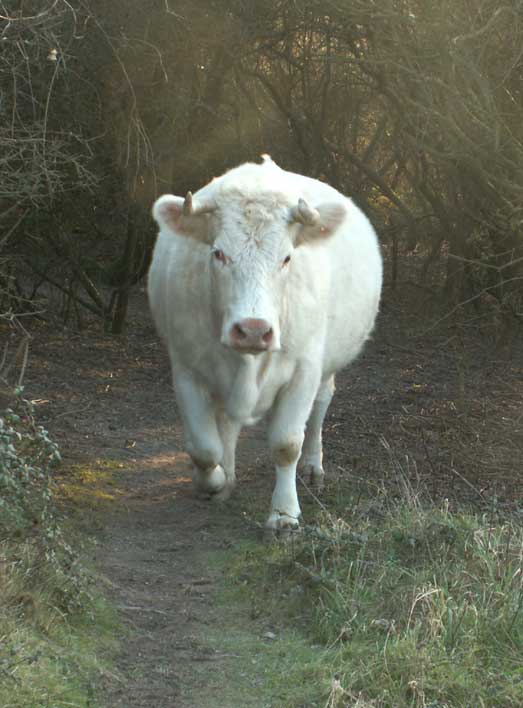 30
January 2006
30
January 2006
There
are cattle
all over Mill Hill from Old Erringham Farm enriching the low nutrient hillsides
with their dung and threatening the flora (Horseshoe
Vetch) and the internationally important
population of Chalkhill Blue Butterflies.
It looks like the fence was broken down deliberately, probably at the instigation
of the South Downs Conservation Board
on public land given to the people of Shoreham.
There is also the danger or erosion, breaking up the steps under the hooves
of the cattle and reduction of the amenity value of the downs. They were
timid cattle and they were shooed of the vulnerable lower
slopes by the public. Most of the dung
was on the steps near the stile in the north-west
corner of Mill Hill Nature Reserve.
First
Draft of the Article for the Shoreham Society Newsletter
18
January 2006
There
were a couple of House Sparrows
next to a small eight caravan illegal encampment in the upper car park
of Mill Hill which are unusual for this area. On the pastures to the east
of Mill Hill a handful each of Rooks
and Magpies
were foraging and on Mill Hill there were a few Crows.
It is muddy under foot when human feet had trampled, with squelchy bits
and puddles.
 |
 |
 |
 |
 |
One tree on the upper slopes sported at least four of the common local lichens.
13
January 2006
My
first visit of the year in the afternoon to the southern area and lower
slopes of Mill Hill failed to find anything remotely newsworthy. The
lower slopes looked more grassy than normal after the rain and there was
still discarded chopped down Privet
laying about. The remains of Carline Thistle
were showing and the scrub was adorned by the straggly remains of Clematis.
There was a discarded mushroom, which was probably Honey
Fungus.
Pixie
Path to Mill Hill (Link)
Mill
Hill Wildlife Reports 2005 (Link)
LINK TO THE WILDLIFE REPORTS FOR AUTUMN - SUMMER 2004
LINK TO THE MILL HILL WILDLIFE REPORTS FOR WINTER & SPRING 2004
| Chalkhill
Blue (3000 +)
Adonis Blue (50 -100) Dingy Skipper (75) |
Small
Heath (250)
Wall Brown (12) Meadow Brown (300) |
Marbled White (50)
Gatekeeper (200) Speckled Wood (>50) Green-veined White (2+) |
Common
Blue (>3000+)
Small Blue (5) Brimstone (8) |
Small
Skipper (>50)
Large Skipper (10+) Grizzled Skipper (20) Brown Argus (>30) |
The other species may breed on Mill Hill, but there main breeding area will be adjoining fields or slightly further away. e.g. Small Blue (included above), Small Copper, Small Tortoiseshell, Green-veined White, Peacock, Ringlet, Small White, Large White, Comma, Holly Blue, Orange Tip. (=10)
The following are immigrants &/or hibernators: Red Admiral, Painted Lady, Clouded Yellow.
The following have not been positively identified (because of ID difficulties): Essex Skipper. This species is now included for a local field on the Adur Levels within 500 metres of Mill Hill.
(=30)
The
following may occur but it has not been positively identified (because
it is elusive and hard to spot): Green Hairstreak.
The next one is no longer
found on Mill Hill but were there in the recent (reduced drastically to
almost extinct by 1948 last record in 1968) past: Dark
Green Fritillary (Records of this butterfly
in 1857, 1938, and 1945 when it was common.)
The next one is no longer
found on Mill Hill but were there in the distant (1947) past: Grayling.
The next one has been recorded
near Mill Hill in the middle distance past: White-letter
Hairstreak
(=34)
The
Silver-spotted
Skipper does not appear to ever have occurred
on Mill Hill
The
Silver-studded
Blue has never been recorded from Mill Hill
The
Short-tailed
Blue was recorded as a single immigrant in
1956.
Link
to the Mill Hill WILDLIFE REPORTS up to 2003
with
lots of Butterfly observations
 Lower
Slopes (with Butterfly Reports)
Lower
Slopes (with Butterfly Reports)
Mill Hill Nature Reserve (including map)
MultiMap Aerial Photograph of Mill Hill
Back
to Mill Hill
Triangle
Upper
Slopes
Middle
Slopes
Lower
Slopes
Grasses
of Mill Hill
Mill
Hill Copse
Aerial
Map
Lower
Adur Levels (MultiMap) including Lancing Clump and Mill Hill
Hippocrepis
comosa (Horseshoe Vetch)
First
Draft of the Article for the Shoreham Society Newsletter